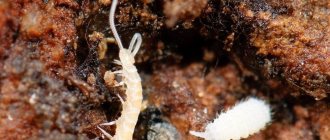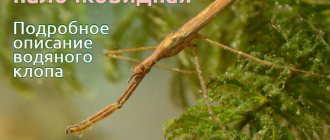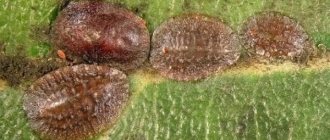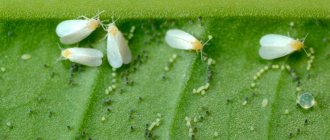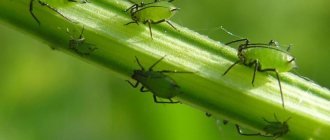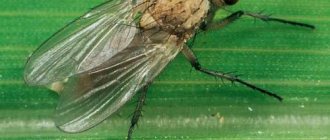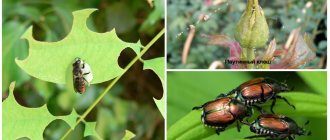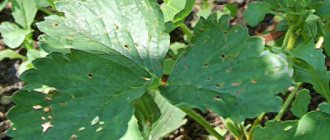Chemicals to the rescue
If it is not possible to mechanically remove the larvae and adult insects that have settled in the roots of the plant (planting in deep tubs), use insecticides: Agravertin, Fitoverm, Confidor. The solution is prepared in the following proportion: 8 g of the drug per bucket of water. If Intavir is used, then 1 tablet of the product is pre-diluted in 10 liters of water.
The product has been tested many times against indoor pests
Podura in flowers feel very confident, so the plant needs to be watered twice every 7 days with an insecticide solution at the rate of 100 ml of the drug per 0.7 liter pot.
Fine-grained sand can be used. It is washed well and dried. The top thin layer of soil (several centimeters) is removed from the pot. The remaining soil is watered with any insecticide against the Colorado potato beetle. A thin layer of sand is scattered on top. Apply granulated Grom-2 or Bazudin, scattering the preparations in small quantities onto a slightly damp soil surface. A thin layer of soil is laid on top and watered abundantly. For greater effectiveness, do not water flowers in pots for 5 days after treatment.
- An infusion of tobacco dust, shag, and red hot pepper is used as a watering solution. Infuse a pound of tobacco waste or shag in 10 liters of water for 48 hours. Add soap shavings (40g) to the strained mixture. The plant itself is sprayed with the finished product and the soil is watered.
- You can also cultivate the soil with a weak solution of potassium permanganate.
- Dry celandine is used. 1 kg of raw materials is poured and infused in water (10 l). The infusion, aged for 24 hours, is filtered. They cultivate the soil.
Radical means of control will not be needed if plant nutrition and watering regime are properly organized and a healthy indoor microclimate is created.
Even if your home is kept perfectly clean, midges can still enter it if you leave the windows or doors open. The favorite habitat of pests is damp and dark areas. They breed near trash cans, animal cages, aquariums or, for example, in flower pots. If you find white midges in the soil of indoor plants, do not panic. There are many folk and chemical methods to effectively get rid of insects.
Methods of pest control
Most springtails, and there are about 8 thousand species of them, lead a secretive lifestyle. Their diet includes fungal mycelium, algae, and lichen. A limited number of springtails feed on plants, but this is what gardeners have to deal with.
Methods for getting rid of dura on indoor flowers can be divided into several groups: mechanical, agrotechnical, folk and chemical.
- it is effective for small infections;
- light particles of the substrate float up - expanded clay, peat.
Mechanical methods of control include cleaning trays, pots, shelves or window sills where flowers stand with a soapy solution.
Advice. Do not leave water in the pan; pour it out half an hour after watering.
The most effective way to combat durs is to reduce watering and dry the soil. Loss of moisture is detrimental to them. The lump of earth is dried in the air in the shade or blotted with napkins. Not every plant can withstand prolonged drought, so you will have to act based on each type of indoor flower. It is worth reviewing the composition of the soil; organic residues are excluded from it - tea leaves, dry leaves. These components promote the growth of fungi, a breeding ground for springtails. Proper drainage is necessary so that moisture does not stagnate in the soil.
Advice. The pot should be selected according to the size of the root system. With a large volume, simple fungi and bacteria fill the free space. A favorable environment is created for the development of springtails.
If there is a large accumulation of pests on the surface, the top layer of soil is replaced. 3-4 cm of soil are removed and clean sand is poured in their place. After 4-5 months, the sand can be replaced with soil. Sprinkling the soil with ash is also effective; this worsens the living conditions of pests.
Folk recipes
A simple and safe way is to lure pests from the pot into the potatoes. To do this, take a raw vegetable and cut it in half. Half a potato is placed cut side down in the ground. Springtails will gather around him. Remove pests with a spatula, along with the soil.
You need to act quickly, but carefully. The collected poduras are placed in a container with a lid (don’t forget about their jumping ability) and then destroyed
This method will not get rid of all pests, but it will significantly reduce their population.
To repel pests, it is recommended to place dry peels of citrus fruits - oranges or lemons - in pots. Sprinkling a thin layer of tobacco dust will help. Watering with the addition of a citramone tablet per 2 liters of water helps control the number of springtails. If the above methods are ineffective, you will have to replace the soil.
Treatment with chemicals
If the soil podra has multiplied in large numbers and eats young shoots, then it is necessary to resort to the use of insecticides. These drugs quickly destroy any plant pests. Among the proven products: Fitoverm, Aktara, Mospilan. The preparations are diluted in water according to the instructions, then poured into the soil. In this case, treatment is not carried out by spraying, as with other types of pests, the soil must be wetted to a depth of 3-4 cm. This will destroy the eggs and larvae.
Another recommended remedy is Bazudin. These are granules scattered over the surface of the soil. A thin layer is enough to kill springtails. The effect of the drug lasts for more than a month.
Attention. Before using Bazudin, please note that it emits an unpleasant odor.
It intensifies when watered. The action of Bazudin has a negative impact on well-being; it is not recommended to use it if there are children in the house.
Another soil insecticide, Pochin, effectively destroys springtails when applied to the soil of a pot. Small granules act on the pest upon contact. It is enough to mix them with soil and the fools will die within a few hours.
- It is better to buy indoor flowers in specialized stores. Before purchasing, it is good to inspect the specimen; if there are any doubts about its health, take another plant.
- Provide good drainage to prevent moisture from accumulating at the bottom of the pot.
- Observe the agrotechnical conditions recommended for plants (temperature, humidity, lighting).
Before starting the fight against durs on indoor plants, you should assess the size of the threat. They are part of the processes of humus formation. Chemicals that harm indoor plants will not be needed if flower care is properly organized.
Who is this silverfish?
Common silverfish (also beautifully called “sugar fish”) are usually called small wingless insects belonging to the bristletail order. The size of the insect is less than two centimeters. The flat body, tapering towards the tail, resembles in its shape an elongated triangle or a silvery drop. Thanks to the small silver-gray scales covering the body, the name of the insect in Russian appeared - silverfish. The white elongated silverfish has two long front and three rear antennae that are clearly visible, and short legs are barely visible along the body. Experts note that the insect acquires a light color only after the third molt, and until that time its color is dark gray. The habitat of silverfish in natural conditions is dark and well-moistened areas, under fallen compacted leaves, stones or old snags. Insects that have settled in an apartment or house will select similar living conditions - they definitely will not like a dry and bright room. Unfortunately, a modern bathroom can be considered an ideal place for the appearance of small parasites of all kinds. It is in this room that silverfish most often appear. Interestingly, according to one version, the homeland of this insect is the tropics, so silverfish are looking for a moist, secluded place at a temperature of 21 degrees Celsius. Light frightens these swift tiny creatures; they lead an active lifestyle in the dark, getting out of their hiding places at night. These insects are quite rare in large numbers in the bathroom, usually one or two individuals.
Silverfish prefer to eat products of plant origin, which may contain starch and polysaccharides. This can be flour, sugar, fabrics, paste, paper - often toilet paper. Sometimes silverfish are brought into the house in a roll of toilet paper, into which it could have crawled in the warehouse. Consequently, this insect can pose a danger to carefully stored family photographs, book bindings, wallpaper and various papers. In addition, from organic food, silverfish can consume mold fungi and unicellular algae, small pieces of garbage accumulated under rugs, old rags, etc. For humans, silverfish are completely harmless, they cannot bite, they do not spread pathogenic bacteria, they do not cause harm to health, but they are annoying only by the fact of their presence in the toilet or bathroom and the rare damage to photographs, toilet paper or wallpaper.
Fools, how to fight?
Drugs for stupidity
If poduras appear, the question of how to get rid of them becomes relevant. Systemic insecticides will help here. For example, you can water the soil with solutions of drugs such as Aktar and Mospilan. Watering is carried out strictly according to the instructions, otherwise you can destroy not only the parasites, but also the plant itself.
You can dilute half a tablet of citramone or axofen in three liters of water. Then water the plant with this water to reduce the number of parasites. In the spring, the cured plant must be replanted into new soil, into a pot of the same size and do not forget about drainage.
What drugs can be used for hypodura:
- "Aktaroy";
- "Mospilan";
- "Carbofuran" (suitable for orchids);
- “Bazudina” are granules that simply need to be scattered over the surface of the soil. With this drug you can destroy a colony within a couple of hours;
- Dust the soil in the hill with wood ash. But this method is not suitable for azaleas, camellias and gardenias, which like to grow in acidic soil.
It is necessary to use insecticides to stop durs from multiplying in your plant only if the colony has become numerous.
Before you get rid of fools in a flower pot with insecticides, you can try some folk methods. They cause much less harm to the plant and are not so dangerous for humans, children and pets.
Folk methods of struggle
Practice shows that you can actively fight fools using folk methods. The most effective way is to sprinkle the damp soil with sand or ash. But for those plants that prefer acidic soil, this method is not suitable.
Fools are afraid of large amounts of water. So, you can get rid of them if you place a pot with a large amount of water. Then most of the colony will simply end up on the surface of the water.
Alternatively, you can replace the top 4 cm layer of soil, because podras lay eggs at a depth of 3 cm. So, this simple method will help reduce the colony and the number of young larvae. In spring, the plant must be planted in soil into which air can easily penetrate and do not forget about the obligatory drainage layer.
Ordinary potatoes will also help get rid of fools. You need to cut the tuber and place it cut side down on the soil. In two days, a large number of individuals will accumulate under the potatoes and all that remains is to collect them.
General information:
Poduras are flower pests that cause horror to the gardener by their appearance alone. Countless numbers of these white insects with nasty antennae crawl in large numbers in a flower pot and can even jump out of it. Podura or springtails in large numbers cause great harm to the plant and multiply quickly.
In total, the family of these parasitic insects includes more than eight thousand species. But real fools do not live in the soil of indoor plants, but their closest relative, the springtail, thrives there. Poduras are found in nature in puddles, swamps, and ponds. They feed on simple mushrooms, algae, lichens and moss.
As soon as the soil of a houseplant runs out of any organic matter, Poduras begin to feed on the roots and shoots of the flower itself. The pests are quite small in size and rarely reach a centimeter. But, still, this allows you to examine them without using a magnifying glass.
Features in the appearance of this parasite will be the absence of wings and the presence of a jumping organ, which is located in the back of the body. When the podura is at rest, this organ tucks under the abdomen.
The number of these parasites in a flower pot will depend on the humidity. The higher the humidity, the faster the larvae develop. Podurs: wrestling requires control of this particular indicator. Podura eggs are laid at a depth of three centimeters; the larvae are similar in appearance to the adult individual, but the white bugs are smaller in size.
Mechanical methods of control
If the springtails still managed to get to the plants, and poduras were found in the orchid, then the first action after isolation should be mechanical cleaning of the affected flower. It is best done with alcohol (ethyl!) or soap solution.
Both stems and leaves are wiped with a moistened sponge three times a week. The affected parts of the plant are immediately removed. The discovery of dura on one of the plants is a reason to immediately check all other plantings.
Another effective technique is setting traps. Good results are obtained by laying pieces of raw potato on the ground near the flower as bait. Within a day or two, most pests accumulate on them, which are easy to collect and destroy.
To guarantee success, it is best to transplant the affected orchid onto a new substrate, after thoroughly washing the plant’s root system.
A radical method is to immerse the orchid pot completely in water. Pests float to the surface and are easily removed. After this procedure, it is recommended to remove the top layer of soil in the pot to a depth of approximately 4 cm.
Preventive actions
Podura may appear in orchids, violets, and other plants. To prevent this from happening, it is better to remember about prevention in advance. First of all, we are talking about proper agricultural technology. The soil should not contain many components that actively decompose (tea brewing, discarded leaves and others).
It is also imperative to avoid overwatering the plant. If there is a lot of moisture, it is recommended to additionally sprinkle the soil with dry sand. This will not allow the fools to actively reproduce in an environment favorable to them. You need to choose pots according to the size of the plants so that the roots occupy all the free space. Podura on orchids or other flowers can appear even with proper care and prevention. In such a situation, you need to know how to deal with the parasite.
Where do midges come from in the soil of indoor plants?
- excessive soil moisture as a result of too frequent watering of plants;
- content in the soil of components that help retain excess moisture;
- contaminated soil brought into the house from the store along with a new flower crop;
- watering flowers with tea leaves or other means not intended for this purpose;
- insects can fly into the apartment through a ventilation hole, an open door or window.
How to get rid of midges in indoor plants using physical methods?
You can solve the problem by replacing the old soil in the flowerpot with new one. This method will completely get rid of pests.
The procedure must be carried out very carefully so as not to damage the roots of the plants. After completion, the flowerpot should be washed with hot water and soapy water.
If there are a small number of midges in the soil of indoor plants, you can partially replace the soil. It is enough to remove only the top layer of soil. Another method is to stick a special tape. Insects stick to it and cannot get back out.
The most popular drugs designed to kill house flies include:
- "Fly-eater";
- "Fitoverm";
- "Raid"
- "Inta-vir";
- "Thunder-2";
- "Raptor"
Traditional methods
If you find midges in indoor plants, you can try to destroy them using time-tested folk methods. Potassium permanganate has a good effect. To water the soil, it is recommended to use a weak solution, otherwise the product may burn the roots of the flowers.
Place four matches (heads down) in the pot and water the soil. After a day, take it out and check if the sulfur has disappeared. If it is not there, you need to repeat the procedure, but with new matches. After about 7 days, the midges and their larvae should die.
Experienced housewives recommend using products with a pungent odor to protect plants, as they repel insects. Take garlic (three heads), cut it into small slices and add to water (1 liter). After 4 days, strain the solution, pour it into a spray bottle and spray the flowers and soil with it.
Near flowerpots with plants, you can pour crushed chalk intended for cockroaches. For greatest effectiveness, the product can be applied directly to the soil. Another option is to draw several lines on the flowerpot with chalk. The ground can also be sprinkled with wood ash. This product not only effectively eliminates pests, but also perfectly fertilizes the soil.
In order to get rid of midges, you can also use the following methods:
- place orange peel in the soil;
- leave garlic cloves near flower pots;
- put incense on the contaminated soil, and after a week replace it;
- Water flower crops with soapy water from time to time.
Prevention
As mentioned above, high humidity is a necessary condition for the existence of woodlice. Therefore, in order to survive your arthropod neighbors, you will first need to “dry out” the bathroom. Make it a rule to ventilate the room every time after taking water procedures. If this is difficult to do (for example, if you have a large family or an adjoining bathroom), simply leave the bathroom open at night. Don’t be afraid, woodlice will not scatter throughout the apartment - it’s too dry for them. Also try to wipe all surfaces in the bathroom dry once a day.
Carry out a thorough cleaning of the entire bathroom, look into all hard-to-reach places, check for any accumulation of water and dirt.
Pay special attention to the spaces under the bathtub, sink, behind the toilet and washing machine. Treat all hidden corners with cleaner. There is no need to do this cleaning every day, but try to repeat it at least once a month
Next you need to take care of waterproofing. Check all plumbing fixtures and water pipes for leaks and repair them
There is no need to do this cleaning every day, but try to repeat it at least once a month. Next you need to take care of waterproofing. Check all plumbing fixtures and water pipes for leaks and fix them.
A heated towel rail will help dry the air in the bathroom. If it is not warm enough, install a heater and turn it on for a couple of hours a day. It wouldn’t hurt to get a hood for the bathroom.
If, as a result of cleaning, you did not find anything that could attract the attention of wood lice and make them settle in your bathroom forever, they are probably coming to visit you from neighboring apartments. In this case, check all the ventilation openings - are there any holes in the mesh? It's also worth checking the floors and walls - you may find cracks between the tiles or in the walls. If any are found, it will not be difficult to seal them and block the woodlice’s access to your apartment.
If any are found, it will not be difficult to seal them and block the woodlice’s access to your apartment.
In this case, check all the ventilation openings - are there any holes in the mesh? It's also worth checking the floors and walls - you may find cracks between the tiles or in the walls. If any are found, it will not be difficult to seal them and block wood lice’s access to your apartment.
Mechanical methods of struggle
Poor quality care, accumulations of dried leaves and excess moisture create ideal conditions for the growth of houseplants. Therefore, to eliminate pests, it is necessary, first of all, to regulate watering, which is the main cause of increased soil moisture. Deprived of their usual and comfortable living conditions, springtails will no longer disturb the plant.
There are other ways to get rid of the fool:
It is very important to comply with indoor humidity levels. To do this, you should ventilate the room more often, dry clothes outside, and provide access to sunlight. A special device that absorbs excess moisture will help regulate the humidity level. Sprinkling the soil with ash or sand is one of the most effective methods of killing podura. It can be used for almost all plantings. The exception is plants growing in acidic soil. These include camellia, gardenia or azalea. To get rid of pests, it is enough to place the pot with the plant in water. After that, all that remains to do on its surface is to collect the floating springtails. Particular attention should be paid to the drainage system. After all, it is the clogging of the holes at the bottom of the flowerpot that causes water to stagnate. A few pebbles, which are placed on the bottom of the pot when replanting the flower, will help to avoid this. Replacing the substrate is another effective method to get rid of springtails
It is important not only to remove the contaminated soil, but also to thoroughly rinse the root system. You should also not use organic fertilizers too often. Residues of tea leaves or ground coffee can cause the development of mold or mildew, so they are added to the soil no more than once a week
After 2-3 days, the organic particles are removed and the substrate is carefully loosened so that the soil is enriched with oxygen. It is important to eliminate all factors that contribute to soil decay and mold. There is another original folk method of getting rid of the fungus, which is safe both for the plant and for the person himself. To do this, you will need a raw potato, which is cut into two parts, each of which is placed cut side down on the substrate. If you lift these halves after a few hours, you will see a lot of pests on them. After which the bait should be shaken off or washed off with water and the “bait” should be installed again.
Common types
The parasite population depends on the humidity level. High humidity promotes active reproduction. Among the most common varieties, it is worth highlighting several main ones.
White . Living in the upper layer of the earth. Favorite places are greenhouses and greenhouses.
Vegetable . Eats ornamental crops and garden plants.
Mushroom . It feeds on young vegetative organs of plants and seedlings.
Why are springtails dangerous for plants?
If springtails appear in the plant, even in small quantities, you need to reconsider the basics of caring for the plant. It is possible that it is over-watered, water stagnates in the pan or the soil itself. Springtails in small quantities will not harm a houseplant. But if there is not enough food, they can begin to feed on the roots, which will lead to their rotting.
Most often, springtails can be found in the earthen coma of such indoor plants as violets, gloxinias, and orchids.
The period when the room temperature is low and the plant stops its growth will be dangerous for the plant. Then the flower does not always have the strength to naturally regenerate even parts of the plant that are not severely damaged by the springtail; such affected areas become “open gates” for various kinds of flower infections.
Causes
Springtails in flowers
Springtails settle in indoor flowers only when there is a favorable environment for their habitat. Usually a fool attracts:
- excessively wet soil, excessive watering and a poorly equipped drainage system are some of the important reasons for the appearance of springtails;
- damp air in a room or greenhouse;
- presence of moss;
- excessive use of organic fertilizers;
- rotting remains of natural fertilizers; tea leaves in combination with stagnant water in the soil or tray are especially dangerous;
- low temperature in the room.
Fools in an orchid - what to do?
Podurs prefer frequently watered soil that contains moss. This is why the parasite often invades orchids. If you notice pests on your favorite flowers, you need to urgently do one of the following:
Reduce watering intensity
It is important to create conditions unsuitable for springtails to reproduce. It is important to understand that lack of moisture is less dangerous than mustachioed parasites. Place several potato cubes near the flower
This vegetable is very attractive to drivers, so they will begin to accumulate on the cubes and can simply be removed. Experts recommend treating plants with a phytoverm solution several times a week. You can also use bactericidal preparations, but not more often than once every two weeks. We lower the flower along with the flowerpot into a container of water - all the parasites will float to the surface of the water and can be simply collected.
Another effective method of fighting fools: sprinkle the soil in the pot with tobacco dust or sand.
Experienced gardeners recommend replanting infected orchids into a new substrate
Before doing this, it is important to thoroughly wash the roots of the plants. In addition, you need to remove all rotten areas and treat the affected areas with activated carbon
Chemical control methods
The advantage of chemicals over other methods is that with their help you can get rid of pests in a very short time
It is important to prevent an increase in the springtail population, as these insects can destroy all young shoots. Therefore, it is better to resort to the use of chemicals
Experts recommend paying attention to systemic insecticides, which are available on the market in a fairly wide range.
But, if the number of pests is not critical, it is better to use other control methods, since chemicals also cause serious harm to the plant’s body.
Folk methods of struggle
Below are the most effective folk methods of combating springtails:
- Herbal decoctions (dandelion, chamomile, garlic): boil 20 g of “herb” in water for 10 minutes, then remove the decoction from the heat, wait for it to cool completely, and treat the affected plants.
- Mustard solution: pour 15 g of mustard powder into 1 liter of boiling water; leave for 2 days and treat the plants. To enhance the effect, the soil can be sprinkled with dry mustard.
- You can also sprinkle the soil with wood ash (layer thickness should be at least 1 cm).
Some gardeners use regular flea shampoo to combat springtails. This product copes well with parasites and does not harm plants in any way.
Some useful tips
It is better to water when the soil is moist so as not to burn the roots, and you should also fertilize when the soil is damp... Remember that you should only use sterilized soil, and purchase plants in a safe place! , Soil. If there is a need to replant or sow something, it is better to “do it in bulk: buy soil, immediately put this package in the bathroom at home, add baking powder to the soil. There, carefully place the substrate into glass containers (for use in the microwave) and cover them with lids. Carefully roll up the bag from under the soil and throw it away, it’s better to take it out of the house right away (you never know what’s in there). Then all the containers, along with the bath, under a hot shower. Containers take turns to be steamed in the microwave (each, 2 times for 10 minutes). That's it, the soil is ready for planting. , Moss. If you need to add moss to the soil (for example, for Saintpaulias), then first you need to pour boiling water over the moss (so that if any of the insects were there, they would cook). Squeeze out the moss and dry. Only dry moss should be added to pots with violets, not fresh, otherwise it will quickly disappear there. , Cora. Boil the tree bark in water for 30-40 minutes, and then steam it in the microwave. , “Alien” insects
If you bring a new plant into your home from the store (or anywhere else, it doesn’t matter), then don’t put it on your bedside tables, tables or shelves, don’t lean it against the walls, and don’t try it on in a new place. Take the newcomer straight into the bath and do the “etching” there.
, The area with the diseased plant must be disinfected. Every nook and cranny, every joint and every crevice of the window sill and window must be very carefully sprayed with alcohol (one might say, pour it in). If the flowers were on shelves or stands, then the whole thing is also sprayed with alcohol (do not underestimate the enemy!), and this procedure should be repeated the next day, just in case. In the hot period, 8 days after the first treatment of flowers, you need to carry out a second one; in the cool period, you can increase this gap by 2 days. Everything is repeated: table, actellik, packages. You can spray all the cracks with alcohol again to be sure. And the last (third) etching is done again after 8-10 days. After this, the permanent locations of the flowers are again sprayed with alcohol.
Solutions and infusions for bugs
Use a solution of potassium permanganate to kill bugs on indoor flowers. It is necessary to spray the plants daily for 1 week.
It is important to carry out a water procedure before this. You need to take the plant affected by the bugs and put it under the shower for 10-15 minutes
After a week-long fight against bugs, you will need to leave indoor flowers for three days. After this time, inspect them carefully. If bugs are still present in some areas, treat with potassium permanganate solution 4 more times. After this, the pests will completely disappear.
Calendula tincture is great for getting rid of bugs. It is diluted in warm water in the following ratio 1:5. The prepared solution needs to be sprayed every other day on indoor plants until the pests completely disappear. In case of severe damage to flowers by bugs, you should use tobacco infusion. There is no need to pre-dilute it. It is necessary to spray each indoor plant affected by pests with it three times at weekly intervals. A similar procedure for getting rid of bugs is carried out using garlic infusion.
Main harm
Every gardener should know what podurs are, how to deal with the pest and what needs to be done to prevent their occurrence. It is no secret that even a small population can cause damage to cultivated crops. And although it is not that big, over time the colony will begin to expand and turn into a huge threat to indoor plants.
Among the main consequences that develop during the activities of subsurfaces, the following should be highlighted:
- Actively eating green leaves and sucking juices from all parts of the plant. The problem progresses with high humidity and temperature conditions from 22 to 25 degrees, because in such an environment insects develop very quickly, penetrating both into the soil and inside the flowers.
- Damage to the root system, as a result of which the plant ceases to receive the optimal amount of nutrients and becomes weak.
- Increased risk of dangerous diseases and germs. By infecting individual parts of plants, podurs open the way for the development of numerous fungi, infections and other troubles.
If you do not take the necessary measures in time, then over time the indoor flower will simply die from the vital activity of the springtail.
Control measures
Podura are almost always present in volumes with mature plants, and it is not necessary to conduct a directed fight against them with normal agricultural technology. The main measure to combat outbreaks of podar numbers can only be compliance with the conditions of correct agricultural technology for growing plants. The substrate should not contain a large number of actively decomposing components (unrotted leaves, tea leaves, decorative sawdust). The volumes must have good drainage to prevent stagnation of moisture in the soil. Watering is moderate, as the soil dries. The volume of the pot should correspond to the size of the root system. The place not occupied in the near future by plant roots will be occupied by fungi, bacteria, algae, the earth will turn sour, and fools will breed.
The number of duras remarkably restrains a number of predatory mites, which are also almost always present in the soil.
If there are too many muds, change the soil to a new one. If history repeats itself, then reconsider the soil composition and watering regime.
In cases where you need to take urgent measures to reduce the number of poduras, you can use systemic insecticides (Mospilan, Aktara, etc.). You can restrain and somewhat limit the number of poduras by also adding citramon or askofen to the water for irrigation (half a tablet per 2-3 liters of water).
When sowing Saintpaulia and Streptocarpus seeds, the soil must be thoroughly steamed.
The container in which the seeds are sown must be sealed and have no drainage holes accessible to the pest. It is especially important to comply with these requirements when there are few seeds, or the germination capacity of the seeds of a given hybrid is very low.
Podurs living in pots are close relatives of the inhabitants of reservoirs. They also prefer high humidity. What do idiots look like? The body shape is elongated, segmented, reminiscent of caterpillars. The color is transparent white, sometimes gray. Body length is 2-3 mm. Whiskers are noticeable on the head.
Their distinctive feature is a growth in the back of the body called a jumping fork. This process allows springtails to push off from the surface and make a jump. A characteristic feature of behavior helps novice gardeners distinguish the podura from another pest - the mealybug. Outwardly, these small whitish pests are very similar, but springtails do not suck plant juice like scale insects. At rest, the fork tucks under the abdomen.
Springtails reproduce by laying eggs. The female buries the clutch into the soil to a depth of 3 cm. The emerging larvae are a miniature copy of the parents.
Adults are quite active; they can be seen on the surface of the ground, on the windowsill near the flowers, or near the drainage hole at the bottom of the pot. In small quantities they are harmless. With uncontrolled reproduction, arthropods eat all the organic matter in the soil and attack the roots and shoots of the plant. More often than other flowers, violets and orchids suffer from the invasion of jumping pests.
Morphology
Springtails got their name due to a special jumping organ (jumping fork) located on the underside of the abdomen. The fork is held in a “cocked” state by a special hook. If necessary, the fork is released and, hitting the ground, throws the collembola forward and upward. Some springtail species have an elongated fusiform body shape. They are traditionally called fools. The other part is distinguished by a rounded abdomen and a spherical body; they are usually called sminturs. In a strict sense, this is not entirely correct. Sminturs are only part of the springtails that have this spherical body shape.
Springtail larvae completely repeat the body shape of adult individuals, differing from them only in size and maturity.
The color of springtails (podur and smintur) is very diverse. Most species have a whitish, gray, yellowish, or brownish color, sometimes with a metallic sheen. Representatives of some genera may have a marbled pattern, or less often one or more transverse stripes. Some mints may have a clear dot pattern.
When growing indoor plants, most often found are white, grayish in color, sometimes with a greenish or silver-metallic sheen.
Photo 2. Jumping fork.
Fighting methods
Folk remedies
How to get rid of fools at home? If a small number of poduras appear in the substrate, do not rush to use chemical plant protection products; they can cause more harm to the orchid than a few insects.
When pests appear, the orchid should first of all:
- Isolate to prevent the spread of dura to other plants;
- Mechanical soil cleaning is carried out.
Good results can be achieved:
- Laying out bait in the form of raw potatoes cut into pieces on the substrate around the plant. In a few days, a large number of springtails will accumulate on it, which are easy to collect and eliminate;
- When immersing a flower with a pot in water for 20 minutes. All adult individuals will float to the surface in the water, after which they are collected and destroyed.
In addition, there are a number of other home methods to combat these insects.
Herbal decoctions of medicinal herbs. These decoctions have long been prepared to combat various harmful insects:
- Flowers of chamomile, calendula, dandelion, yarrow. To prepare a decoction, add 0.5 liters of water to 20 g of dry plants, bring everything to a boil and remove after ten minutes. Cool at room temperature, filter and treat the affected plants;
- Infusion of marigolds. Faded marigolds along with the leaves are poured with hot water in a 1:1 ratio and left for two days.
After treating the orchid with herbal decoctions, you should record the date of spraying in order to repeat the procedure after 7-10 days.
Herbal infusions are made against fools.
You can also use other solutions:
- Mustard solution. To prepare the solution, mustard powder (15 g) is poured into 1 liter of hot water and infused for 2 days. The resulting preparation is sprayed onto the plant, and dry mustard is sprinkled onto the soil;
- Mulching the soil with birch wood ash. A good result in the fight against springtails is obtained after sprinkling the soil with wood ash (birch ash is best) in a layer of one or two centimeters;
- Anti-flea shampoo for animals. A solution with the addition of flea shampoo showed unexpected effectiveness. To prepare 1 tbsp. l. shampoo is dissolved in a bucket of water, the plant and substrate are sprayed. After a short time after treatment, the orchids disappear.
The listed measures, which are used individually or in combination, are sufficient to protect indoor plants from any number of springtails.
Fitoverm
Fitoverm is a natural pesticide that is obtained during microbiological cultivation of the producing fungus. The drug is environmentally friendly, as a result of which its effect on the orchid will be minimal:
- The insect absorbs the drug along with food, as a result of which the poison affects only mature individuals and larvae. Podura eggs remain viable after treatment with phytoverm, so after 6-7 days it is necessary to spray again;
- Fitoverm is not mixed with other insecticides or fungicides.
To spray an orchid, 2 ml of the drug is dissolved in 50 ml of water, 0.1 liter of solution is consumed per plant.
Chemicals
If it was not possible to get rid of the larvae and adults using the methods described above, then you should use chemicals. Currently, there are a number of agents that have shown effectiveness against springtails:
- Bazudin is a powdery product; a thin layer of it is scattered over the surface of the substrate. As a result, after just a few hours, springtails will no longer annoy the plant;
- Pochin - used similarly to bazudine. To increase the efficiency of the process, the scattered preparation is mixed with a small amount of earth;
- Aktara is a universal drug, used in the form of a solution, which is used to water the soil and dilute it according to the instructions;
- Mospilan is also used to treat soil against podura in the form of a solution.
Chemical agents effectively help in the fight against fools.
These drugs will help control pests in a short time.
Precautionary measures
When working with insecticides, it is necessary to comply with safety rules:
- Children and pets are not allowed near the sprayed orchid;
- Work with insecticides is carried out with gloves and a respirator;
- After finishing work, the tools are thoroughly washed and stored in a separate place;
- In case of contact with skin, the insecticide is washed off with water and detergents. If the product gets into the eyes, rinse with running water;
- It is prohibited to eat or drink while carrying out work.
Used ampoules or packaging are wrapped in polyethylene and thrown away, the remaining solution is poured down the drain.
Rules for using chemicals
Chemicals also cannot be called a cure for all diseases, and they are by no means safe for the environment. Their use is justified only for especially valuable plants, when all other, more gentle, means have already been exhausted.
- You should always strictly follow the manufacturer's instructions and under no circumstances use chemicals intended to protect plants outdoors indoors.
- Chemical protective equipment should only be stored in places inaccessible to children and pets. Handle residues carefully as they are highly hazardous waste.
- Don’t forget about self-defense, wear gloves and try not to get it in your eyes or inhale the product.
- Do not use products marked with a skull symbol and classified as T+, which means highly toxic, and T, which means poisonous.
- As a last resort, use drugs with a cross sign and the designations Xn, , is poisonous to a small extent, and Xi, is irritating.
- “Of the commercially available plant protection chemicals are not marked with any signs at all, because they are not at all dangerous.
Products for treating flowers against thrips and aphids
The larvae are wingless, yellow, even smaller - 1 mm. Thrips lay eggs in leaf tissue. The larvae emerging from the eggs stay in groups on the underside of the leaves, and adult insects and larvae suck the juices out of them. The upper side of the leaf, damaged by many injections, acquires a silvery sheen. When there is a large concentration of pests, the surface of the leaves becomes covered with excrement in the form of a black coating. As a result of thrips infestation, the leaves turn yellow, dry out and fall off.
How to get rid of these pests on flowers in the garden? An effective way to combat thrips is to spray plants with any insecticide when pests appear. If repeated spraying is necessary, the preparations should be alternated.
These pests of garden flowers reproduce very quickly. They deform leaves, shoots, flowers, oppress and weaken plants, and reduce their decorative value. By sucking large amounts of juice from plants, aphids excrete excrement in the form of a sticky liquid that contaminates the leaves. Various species of aphids inhabit eschscholzia, helichrysum, zinnia, celosia, nasturtium, poppy, calendula, etc.
External signs of damage
It is quite easy to notice that fools have grown on a houseplant. These are small white, cream-colored caterpillars (some species may have a green, silvery tint) that can be seen with the naked eye. They have antennae.
Springtails are usually found in small quantities in any soil. But against the background of high humidity, they can begin to actively reproduce, which will negatively affect the indoor plant.
If silt appears on the surface of the soil, then soon you can expect that podurs will appear in large numbers. Wet soil, when the plant begins to slowly rot from excessive moisture, is an ideal environment for the development of these parasites. It is important to understand that the signs of damage, especially in the first stages, will not be noticeable: after all, the root system is mainly affected. But soon the plant will begin to wither, weaken, and the leaves will turn yellow. However, podurs operate on the soil surface and are easy to notice, even without signs of obvious damage to the plant.
How to control pests on indoor plants
Many novice gardeners are wondering how to deal with pests of indoor plants. The answer to this is important, since insects multiply rapidly, time must not be wasted.
There are different ways to help get rid of pests:
- mechanical;
- biological;
- folk;
- chemical.
If pests of indoor plants are correctly identified, and measures to combat them will be effective.
Mechanical
You need to start with the measures that are safest for humans, especially since they often help a lot. Before starting work, you should disinfect and sharpen your tools. All damaged leaves and shoots are cut off, and the cut areas should be sprinkled with activated carbon. Bugs and visible larvae are selected manually: scale insects, slugs, caterpillars. Leaves with pests such as aphids can be wiped with a cotton pad. A contrast shower and spraying with water helps get rid of pests living on the green parts of the plant.
Biological
How to fight harmful insects with biological means? Such preparations are created based on plants. Most often used:
- "Fitoverm";
- "Agrovertin";
- "Iskra-Bio".
Before use, you should read the instructions. Since they destroy pests, they contain poison in small doses. The plants are treated early in the morning and left in a shaded place until all parts of the plant are dry. The room where the treatment was carried out is ventilated. You need to wash all exposed parts of the body with warm water and detergent.
Traditional methods
If indoor plant pests appear, treatment can be carried out with time-tested folk remedies. For this, decoctions and infusions are prepared from:
- yarrow;
- chamomile;
- dandelion;
- marigolds;
- nettle;
- garlic;
- Luke;
- peels of oranges, tangerines, lemons.
These environmentally friendly and harmless plants can effectively destroy harmful insects. Steamed citrus peels can be buried in the soil. Insects don't like their smell.
An infusion of tobacco, stove ash, a solution of potassium permanganate, furatsilin or soda works well. To prevent the liquid from immediately draining from the plants, laundry soap is added to it.
Chemical
When using chemical pest control products, rapid success can be achieved. It is better to resort to their help as a last resort if other methods have not given a positive result. It should be remembered that such products are unsafe for humans and beneficial insects. You need to work with chemicals with the window open, removing children and animals from the room. In addition, when working you need to use personal protective equipment. After work, you need to thoroughly wash your hands and face. The treated plants are placed in the shade until the solution is completely dry. The area where the treatment was carried out must be washed with hot water and detergents. Remember that chemicals are toxic, therefore, they should be stored in places inaccessible to children and pets. Popular and effective remedies for pests of indoor plants:
- "Karbofos";
- "Chlorophos";
- "Syphos";
- "Trichlorometaphos";
- "Pyrethrum";
- "Decis";
- "Fury."
They are capable of destroying almost all harmful insects.
Insecticidal preparations
Insecticides of contact and systemic spectrum are effective means of controlling pests of plants and flowers. Since their range is quite large, a number of features of some should be considered.
Many gardeners try to avoid the unnecessary use of chemicals due to their toxicity. In fact, they are dangerous only for pests, and not for humans. The degree of toxicity of any composition is determined by the LD50 level, which determines the maximum amount of a substance required to be consumed or inhaled to cause death.
Insecticides against harmful insects, in most cases, are low-toxic and safe for people. They contain only substances harmful to insects. The lethal dosage for humans usually exceeds several hundred grams.
You should not focus on the smell, as most chemicals have a strong and unpleasant smell. Modern drugs are produced without fragrance, but do not lose their effectiveness in killing pests. When choosing a drug for exterminating plant insects, it is better to use different groups in turn: organophosphorus, neonicotinoid, pyrethroid. This technique helps prevent the development of immunity in insects.
Today, an expanded selection of insecticides is available for sale. The most popular drug is "Aktara", endowed with a wide range of damaging effects on plant pests and absolutely harmless to surrounding people.
Available in the form of microencapsulated water-soluble granules. The aqueous solution obtained from them does not emit an unpleasant odor. The advantage of the product is that it is systemic - after application to the plant it accumulates in the tissues for a long period of time, providing protection against parasites for at least 2 weeks.
Progressive chemicals include Apache, which is similar in composition to Aktara. The product is more economical to use.
List of modern chemicals:
- Pegasus;
- Rogor;
- Talstar;
- Fury;
- Arrivo;
- Cypermethrin;
- Talstar.
Biological drugs include:
- Verticillin;
- Mikoafidin.
To help gardeners, there are various sticky traps that are placed near the affected plantings.
No less common in home use are herbal products that have insecticidal and acaricidal effects. These include infusions: red pepper, onion, garlic, tobacco. They are effective against: aphids, scale insects, thrips, mites.
